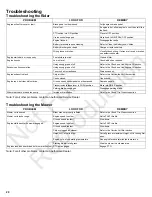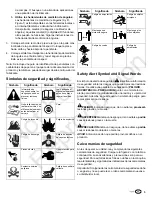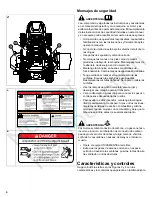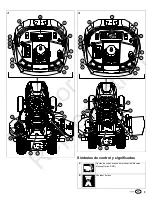
8
Start the Engine
WARNING
Fuel and its vapors are extremely flammable and explosive.
Fire or explosion can cause severe burns or death.
When Starting the Engine
• Ensure that spark plug, muffler, fuel cap, and air cleaner
(if equipped) are in place and secured.
• Do not crank engine with spark plug removed.
• If engine floods, set choke (if equipped) to OPEN/RUN
position, move throttle (if equipped) to FAST position and
crank until engine starts.
9
1.
Make sure the starter insert (E, Figure 9), if equipped, is in
place before starting engine.
2.
Engage the parking brake (G). Fully depress the brake
pedal, pull UP on the parking brake control, and release
the brake pedal.
3.
To disengage Power Take-Off (PTO) (B), push the PTO
down.
4.
Move the throttle control (C) to the FAST position.
5.
Press the START/STOP push button (D) and release as
soon as the engine starts, or insert the key into the ignition
switch and turn it to the ON/START position.
Note: If the engine does not start after repeated attempts, go
to or contact an authorized dealer.
6.
After the engine starts, move the throttle control (C) to half
speed. Warm up the engine by running it for at least 30
seconds.
7.
Move the throttle control (C) to the FAST position.
Note: To immediately stop the engine In an emergency, press
the START/STOP push button (D) or pull out the starter insert
(E), if equipped, or turn the ignition switch to STOP. For normal
shut down, refer to the
Stop the Engine section.
Stop the Engine
1.
Release the ground speed pedals (A, Figure 9) to return to
the NEUTRAL position.
2.
Disengage the Power Take-Off (PTO) switch (B) and wait
for all moving parts to stop.
3.
Move the throttle control (C) to the SLOW position.
4.
Press the start/stop push button (D) to STOP the engine,
or turn the ignition key to STOP the engine.
5.
Remove the starter insert (E), if equipped, or ignition key
and keep out of the reach of children.
6.
Engage the parking brake (G).
a.
To engage the parking brake, fully depress the brake
pedal (F), pull UP on the parking brake control (G), and
release the brake pedal (F).
b.
To disengage the parking brake, fully depress the brake
pedal (F), press DOWN on the parking brake control
(G), and release the brake pedal (F).
Operate the Rider for Mowing
Automatic Controlled Traction (ACT)
Automatic Controlled Traction (ACT) is an exclusive feature of
the transmission that provides improved traction. ACT applies
a preset amount of torque to both rear wheels, even if one starts
slipping. A transmission without ACT will lose traction completely
if one rear wheel starts slipping. The preset torque is just enough
to provide additional traction, and still allow the wheels to turn
at different speeds in a tight turn without damage to the lawn.
11
Not
For
Reproduction












































